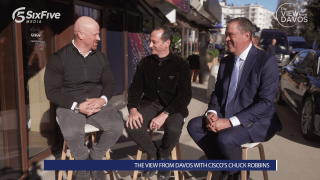The Six Five team discusses AMD, Intel, Tech Titans Extend X86 ISA
If you are interested in watching the full episode you can check it out here.
Disclaimer: The Six Five Webcast is for information and entertainment purposes only. Over the course of this webcast, we may talk about companies that are publicly traded and we may even reference that fact and their equity share price, but please do not take anything that we say as a recommendation about what you should do with your investment dollars. We are not investment advisors and we ask that you do not treat us as such.
Transcript:
Daniel Newman: AMD and Intel, what happened this week? Are they collaborating?
Patrick Moorhead: Yeah. A little backdrop here. So, gentleman named Jerry Sanders and Robert Noyce used to work for a company called Fairchild Semiconductor. The two of them left. Jerry was in sales and Robert Noyce was product kind of engineering. And, Jerry went off and formed AMD and Robert Noyce formed Intel and it’s pretty much been a hate-hate relationship for close to 50 years. It was fun when the two of them were publicly sparring. Jerry Sanders actually hired me into the company in end of 2000, but I was in and around Intel for the previous 20 years as a product manager at Compact computer, the number one computer maker and server maker. But, for the first time in 50 years, the CEOs of AMD and Intel were on a video together and that was The Six Five video and got pictures together. That was in the context of The Six Five. So, history making.
So, a little bit more backdrop. Every piece of software speaks a certain language. It’s called an ISA, an instruction set architecture. There is x86, there is power, there is ARM and even MIPS out there. I’m sure there’s one other historical one, oh, RISC-V, my gosh. So, each one of these speaks different language and they also have extensions for acceleration. What happens if you “fork” an operating system or an application, is you have to write a separate piece of code depending on the fork. And currently ISVs have forks for AMD and Intel so they have to carry two sets of code. The base set is obviously compatible, but when it comes to things like security extensions like AVX and AMX, it is not consistent, even some memory handling stuff. And, the industry wanted it to be easier. And, to the credit of AMD and Intel, they have agreed to collaborate on those things so their ISVs and partners don’t have to do a lot of work.
And, the other backdrop is that ARM is getting a lot more into the x86 space into personal computers with Apple and Qualcomm and soon to be NVIDIA MediaTek and also on the server side, merchant silicon providers like Ampere, but more importantly the homegrown silicon at Amazon, Microsoft and Google enabled by companies like Marvell. So, with that said, there was a huge announcement coming out. It wasn’t just AMD and Intel, it was the CEOs of Dell, it was Broadcom VMware, it was Satya Nadella, it was Meta, it was Google and Red Hat CEO. And, I’m sure I’m forgetting a bunch of other ones but to be determined on what the announcements… I don’t know if it’s going to be public. I don’t know if we’re going to get any more information outside of this, but instead of Intel and AMD kind of working through their ISVs and partners to come, it’s going to be AMD and Intel actually sitting in the same room with those partners to determine the future of x86 and instructions.
Two things though, Daniel, that I still can’t get underneath is the press release talked about x86 growth. We asked the question to Lisa and Pat, “Does this mean that they’re going to get bigger into automotive? Does this mean they’re going to get bigger into smartphones phones?” I just don’t know. And then there’s the comment on chiplets. I still don’t understand why that was part of that. I think we asked point-blank, “Does this mean that, okay, Intel and AMD, you guys might license a chip IP kind of like a CPU IP, kind of like ARM does?” But, to be determined, very provocative though.
Daniel Newman: Yeah. This was a pretty big moment, Pat, and you and I were lucky enough to have them on our platform to talk to them. And, I’m not sure that people realize what a monumental moment it actually was to have Lisa, Pat in the same room on the same video at the same time. But it was really a lot of fun, Pat, to be part of that. You did a great story on Forbes digging into this. I think that was probably the best color I saw. I had a lot of press calls about it. It’s funny how people don’t seem to fully understand the part that you explained in the beginning, how complicated it can be going from x86 to x86, and I think opening the sort of – there, making that simple, which by the way was very intentional, I think, in many ways it created friction from moving from one to the other when that was the only game in town.
Where this cast a mark for the industry more at large though is that we’ve hit the inflection where the power of ARM and the power, and this is indirectly in video too, is becoming so much more significant than the risk of them kind of cannibalizing each other’s market share, that they’re willing to collaborate more to sort of reduce some of that friction, improve the experiences of people on the x86 platform and basically try to protect their current market leadership, Pat. And, you asked about growth, well, it’s probably not going to come from the core businesses because, what do they have? Over 90% of the server market and they still have over 90% of the PC market. Now this is changing. And, of course the AI servers, AI doing more stuff, inferences, XPUs, these new kind of chips are all going to take workloads and take them off of potential x86 and move them to other potential platforms.
And this, of course, it’s the existential risk that x86 is facing right now. So, Pat, I mean, it’s a little defensive, the move, in my taste. I think it’s a little defensive, but I do think it’s the right move. I think it’s the necessary move. And, of course we’re going to see how this all plays out. We’ll see what real value it brings. We’ll see how it continues to manifest itself in the community, Pat. But interesting times, to say the least. I think every part of the country I’ve been in this week, I’ve had somebody say to me, “Oh my God. I can’t believe you guys sat down with Lisa Su and Pat Gelsinger together.” Maybe only more strange would’ve been the original founders that you mentioned sitting down for a conversation like this. But a lot of fun, Pat. I really enjoyed doing that with you. Maybe at some point we’ll have Lisa, Pat, Jensen and Rene on a video together. Who knows?
Patrick Moorhead: Yeah. And just to put the numbers out there, so Intel still has 70% of the data center server market. AMD has a little over 32% of x86. And, this would’ve never happened if AMD weren’t in the power position that it had, where it has upwards of 80% market share at hyperscalers, like Meta and probably 40% to 60% overall at hyperscalers and hyperscalers write their own code. They don’t like the fork either. And VMware live migrations, all that stuff hopefully is out of the window here.
Daniel Newman: And, to be clear, I was talking about combined market share. I wasn’t talking about any individual. I just meant they still have the vast majority of all data center CPU. Now, if you talk about all data center computing, it’s not 90% anymore because so much AI compute is going to change the way that number is going to be constructed long term. And in PC’s ARM is just starting to really… But, you’re hearing numbers like, in the next three to five years ARM believes it could be at 50%. That is-
Patrick Moorhead: Yeah. That’s right. And that’s the combined Apple plus Qualcomm, MediaTek and NVIDIA coming out. Yeah. Rene Haas made that declaration at Computex this year that you and The Six Five attended.






















































































